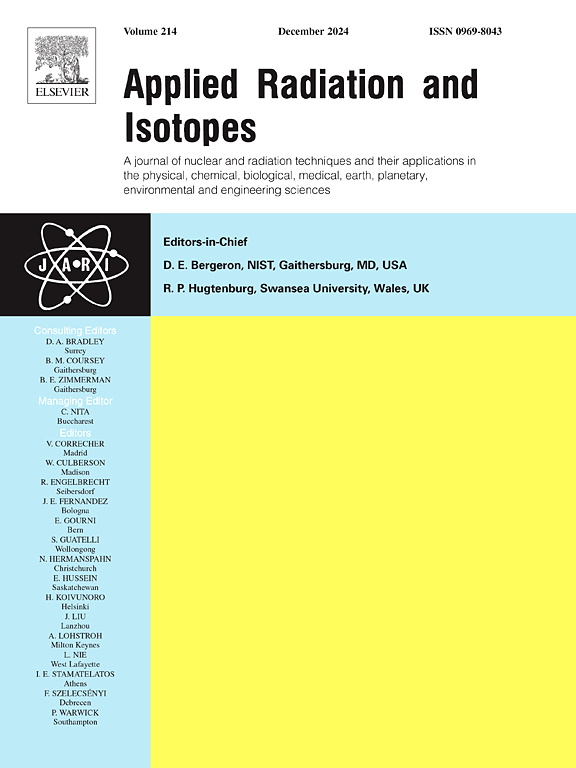AllinOne放射性合成器上[18F]FDG和[68Ga]Ga-DOTA-TATE的顺序合成:单盒和试剂负载的全自动双放射性核素方案
IF 1.6
3区 工程技术
Q3 CHEMISTRY, INORGANIC & NUCLEAR
引用次数: 0
摘要
开发统一高效的PET显像剂自动合成方案对于提高操作效率和安全性至关重要。本研究旨在使用AllinOne 36阀合成模块,简化18F-氟脱氧葡萄糖([18F]FDG)和[68Ga]Ga-DOTA-TATE的顺序生产过程,只需单个盒体和试剂装载,以提高热池利用率并减少操作人员的辐射暴露。该方案旨在允许顺序合成,而不需要重复的热室访问或等待辐射水平降低,从而减少PET显像剂生产所需的时间和资源。结果本研究证明了新设计的合成方案的稳定性和可靠性。两批[18F]FDG的活性率分别为73±6.2%和64±4.7% (n = 3),合成时间均在23 min左右,放射化学纯度均在96%以上。[68Ga]Ga-DOTA-TATE的收率为71±5.8%,合成时间约为18 min (n = 3),纯度超过97%。合成产物符合所有质量控制标准,包括外观、pH值、放射性浓度、无菌性、内毒素水平和溶剂残留。结论单盒方案显著提高了效率,减少了辐射暴露。高收率和高纯度证实了其临床可行性,确保了PET显像剂的可用性。这种可扩展的解决方案通过简化生产过程和在一天内满足不同患者对不同PET显像剂的需求来增强患者护理,展示了其在临床环境中的潜力。本文章由计算机程序翻译,如有差异,请以英文原文为准。
Sequential synthesis of [18F]FDG and [68Ga]Ga-DOTA-TATE on the AllinOne radiosynthesizer: A fully automated dual-radionuclides protocol with single cassette and reagents loading
Background
The development of a unified and efficient protocol for the automated synthesis of PET imaging agents is crucial for enhancing operational efficiency and safety. This study aimed to streamline the sequential production process of 18F-fluorodeoxyglucose ([18F]FDG) and [68Ga]Ga-DOTA-TATE with only single cassette and reagents loading using the AllinOne 36-valve synthesis module, with the goal of improving hot cell utilization and minimizing radiation exposure for operators. The protocol was designed to allow for sequential synthesis without the need for repeated hot cell access or waiting for radiation levels to decrease, thereby reducing the time and resources required for PET imaging agent production.
Results
Our study demonstrated the stability and reliability of the newly designed synthesis protocol. The activity yields for two batches of [18F]FDG were 73 ± 6.2 % and 64 ± 4.7 % (n = 3), respectively, all with synthesis times about 23 min, and with a radiochemical purity consistently over 96 %. For [68Ga]Ga-DOTA-TATE, the yield was 71 ± 5.8 % with synthesis times about 18 min (n = 3), with a purity exceeding 97 %. The synthesized products met all quality control criteria, including appearance, pH value, radioactivity concentration, sterility, endotoxin levels, and solvent residue.
Conclusion
The single-cassette protocol significantly improved efficiency and reduced radiation exposure. High yields and purities confirm its clinical feasibility, ensuring PET imaging agent availability. This scalable solution enhances patient care by simplifying the production process and meeting the demands of various patients for different PET imaging agents within a single day, demonstrating its potential in clinical settings.
求助全文
通过发布文献求助,成功后即可免费获取论文全文。
去求助
来源期刊

Applied Radiation and Isotopes
工程技术-核科学技术
CiteScore
3.00
自引率
12.50%
发文量
406
审稿时长
13.5 months
期刊介绍:
Applied Radiation and Isotopes provides a high quality medium for the publication of substantial, original and scientific and technological papers on the development and peaceful application of nuclear, radiation and radionuclide techniques in chemistry, physics, biochemistry, biology, medicine, security, engineering and in the earth, planetary and environmental sciences, all including dosimetry. Nuclear techniques are defined in the broadest sense and both experimental and theoretical papers are welcome. They include the development and use of α- and β-particles, X-rays and γ-rays, neutrons and other nuclear particles and radiations from all sources, including radionuclides, synchrotron sources, cyclotrons and reactors and from the natural environment.
The journal aims to publish papers with significance to an international audience, containing substantial novelty and scientific impact. The Editors reserve the rights to reject, with or without external review, papers that do not meet these criteria.
Papers dealing with radiation processing, i.e., where radiation is used to bring about a biological, chemical or physical change in a material, should be directed to our sister journal Radiation Physics and Chemistry.
 求助内容:
求助内容: 应助结果提醒方式:
应助结果提醒方式:


